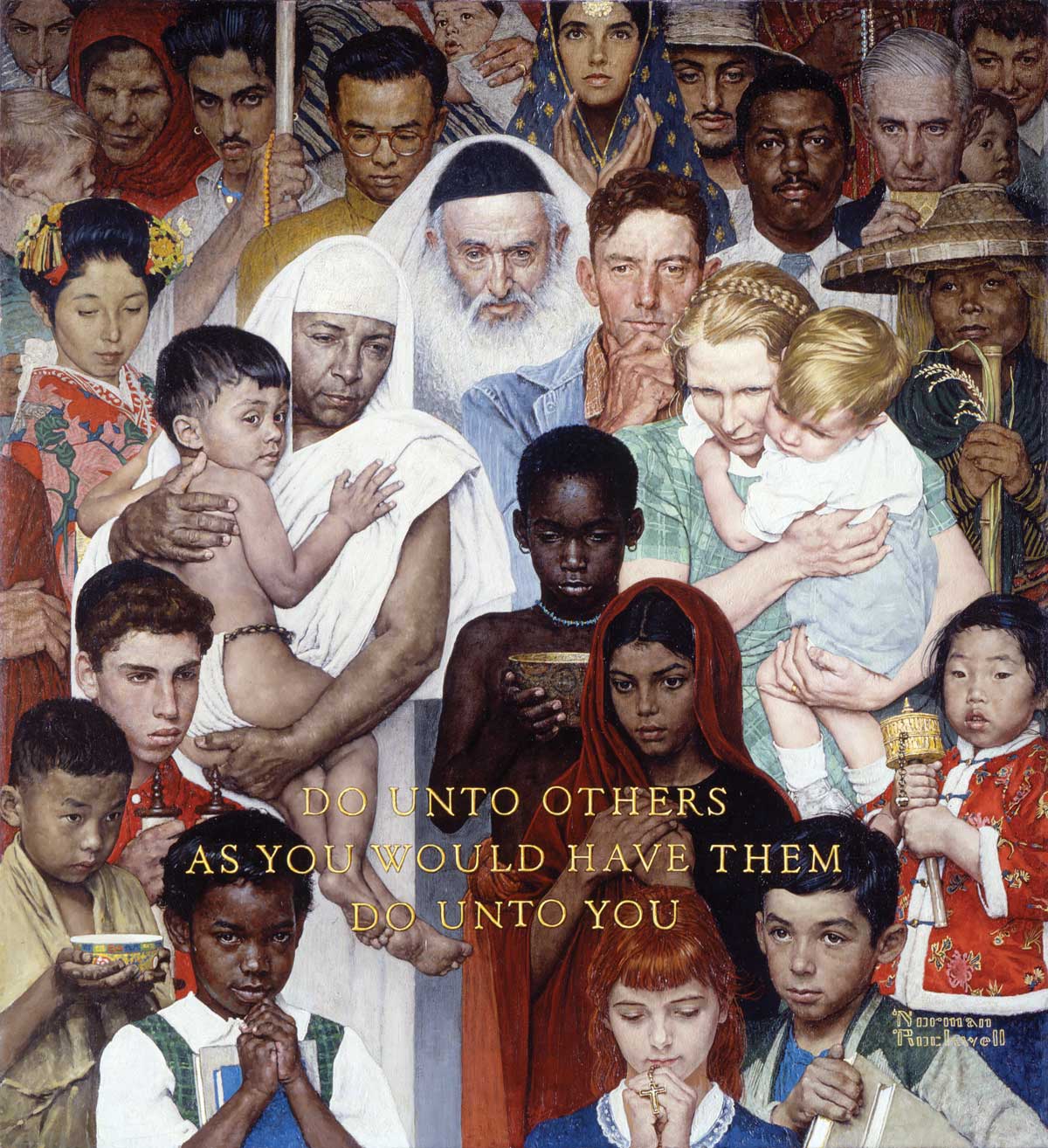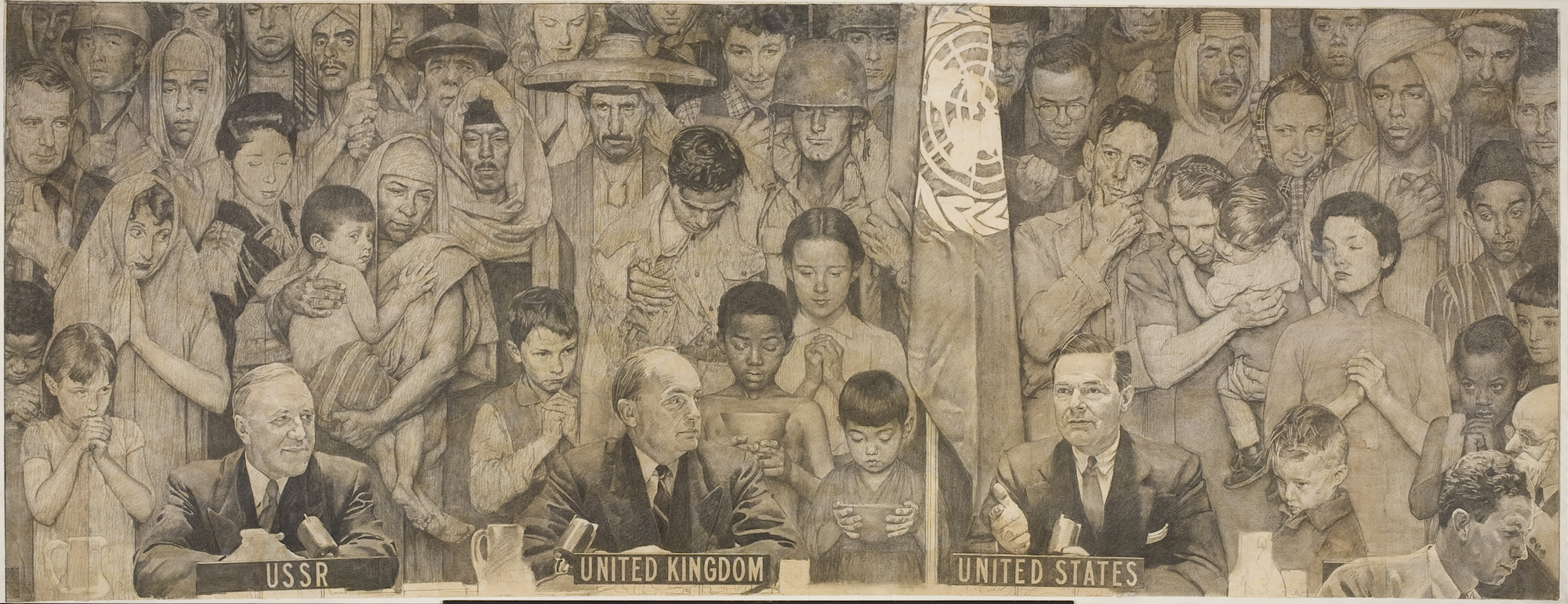Golden Rule: A Personal Reflection
Overview:
Students engage in a small group or class discussion based on the illustration, Golden Rule, and its principle, “Do unto others as you would have them do unto you.”
Following the discussion, students write a personal reflection of this principle. Writings may reflect ways that students try to incorporate this principle in their lives. Additionally, students consider the ways the practice of this principle could help to create a more peaceful and harmonious world.
Enduring Understandings/ Essential Questions:
- Do unto others as you would have them do unto you, is a principle that guides the way people treat others.
- Personal reflections allow writers to think about how their lives are influenced or have changed due to new or past experiences or learnings.
- What does the principle, Do unto others as you would have them do unto you, mean?
- What does this principle look like?
- What would the world be like if all citizens of the world followed this principle?
- How is personal reflective writing different from other genres of writing?
- Grade
- 3-5
- Theme
- Four Freedoms
- Length
- This activity may take 3 periods or less for a short unpublished writing assignment. It may take up to 2 weeks if students take their piece through all steps of the writing process to be shared publicly.
- Discipline
- Social Studies; Language Arts: Speaking and Listening; Language Arts: Writing
- Vocabulary
- Personal reflection
Objectives:
- Students will participate in a discussion of the Golden Rule; what it means and how Norman Rockwell chose to represent it.
- Students will reflect on what the Golden Rule means to them and any role it may play in their lives.
- Students will write a personal reflection sharing their thoughts and ideas about the Golden Rule.
Background:
Norman Rockwell is a visual storyteller. He painted pictures that were seen on the cover of a magazine called The Saturday Evening Post for forty-seven years. His paintings, also referred to as illustrations, reflected life in America. They also served to draw attention to ideas that Rockwell felt were important and that he wanted people to think about.
Golden Rule, 1961
Cover illustration for The Saturday Evening Post, April 1, 1961
Oil on canvas
Norman Rockwell Museum Collection, NRACT.1973.010
Golden Rule, a gathering of men, women, and children of different races, religions, and ethnicities, was a precursor of the socially conscious subjects that Norman Rockwell would undertake in the 1960s. “Do Unto Others as You Would Have Them Do Unto You” was a simple but universal phrase that reflected the artist’s personal philosophy. A citizen of the world, Rockwell traveled throughout his life and was welcomed wherever he went. Of the painting Rockwell said, “I had tried to depict all the peoples of the world gathered together. That is just what I wanted to express about the Golden Rule.”
Rockwell’s Golden Rule painting later served as the inspiration for a glass mosaic that was presented to the United Nations in 1985 as a Fortieth Anniversary gift on behalf of the United States by then First Lady Nancy Reagan, made possible by the Thanks-Giving Square Foundation. Rockwell’s Golden Rule painting and his United Nations drawing were exhibited at the United Nations in honor of this humanitarian organization’s Seventieth Anniversary of the United Nations, an expression of his appreciation for humanity and democratic ideals.
Norman Rockwell
Notes for Golden Rule 1961
Typewritten document
Norman Rockwell Museum Collection
In preparing to paint his 1961 Post cover, Rockwell aptly noted that many countries, cultures, and religions incorporate some version of the Golden Rule into their belief system.
Norman Rockwell (1894-1978)
United Nations, 1953
Unpublished study
Graphite and charcoal on paper
Norman Rockwell Museum Collection, NRACT.1973.113
In 1952, at the height of the Cold War and two years into the Korean War, Rockwell conceived an image of the United Nations as the world’s hope for the future. His appreciation for the organization and its mission inspired a complex work portraying members of the Security Council and sixty-five people representing the nations of the world—a study for an artwork that he originally intended to complete in painted form. United Nations never actually made it to canvas, but Rockwell’s desire to reach out to a global community found its forum on the cover of The Saturday Evening Post in Golden Rule nine years later, in 1961. Pictured here are Security Council Members, Soviet Ambassador Valerian Alexandrovich Zorin, British Ambassador Sir Gladwyn Jebb, and United States Ambassador Henry Cabot Lodge.
Materials:
Multimedia Resources
Golden Rule
United Nations
Classroom supplies:
- Writing paper or writing notebooks
- Writing implements
- Optional materials:
- Samples of reflection writing
- Chart teaching what reflective writing is and what is it is not
- Planning outline
Optional support materials:
Tolerance.org: Information about Arthur Interactive Media (AIM)Buddy Project
http://www.tolerance.org/magazine/number-55-spring-2017/feature/buddy-arthur
CPBS/CPTV: This site lists books/video episodes from the Arthur series by Marc Brown which address Character topics such as empathy, honesty, etc.
https://d43fweuh3sg51.cloudfront.net/media/media_files/5b643cf1-047a-40b4-8d3e-cc1b022f4e35/86ea37bd-1d39-4484-a3c4-14e566f5196d.pdf
Information about writing a reflective response
http://reflective-essay.org/what-is-reflection-paper
Reflective Writing Rubric
http://www.readwritethink.org/files/resources/lesson_images/lesson963/Rubric.pdf
Activities:
- Following the close reading of Norman Rockwell’s illustration, Golden Rule, initiate a discussion as a class or in small groups to discuss meaning of the illustration as well as the principle. Give students opportunity to reflect on the meaning of the golden rule, the role it may play in their own lives as well as in the world at large.
- Some guiding ideas to get discussion started might include: What are some ways that you incorporate the Golden Rule in your own lives? Do you think all people are guided by this principle? Should they be? What would the world be like if all people were guided by this principle?
- If students are unfamiliar with reflective writing, share some examples with them. Have them note differences from other types of writing. The link above includes examples of reflective essays that may be used. In addition, there is information about what reflective writing is and is not. A planning outline is also available.
- Have the students think about their understanding of the Golden Rule and the principle, Do unto others as you would have them do unto you. Invite them to write a reflection piece about the golden rule and the principle. This may focus on how the principle applies in their lives. Some students may wish to take a broader look at the Golden Rule painting and the principle, showing how the world would be different if more individuals and groups followed this principle.
- Teachers may choose to use this as a short write activity. If a polished final piece is desired, teachers can have students take the piece through all steps of the writing process.
- Whether the piece is completed as a short writing assignment or as a longer polished product, students should be given opportunity to share their work in a manner appropriate to the product. A fish bowl sharing, inviting students to read their pieces to the class or in small groups, might be appropriate for the short reflective writing assignment. If the student product is a polished final piece, a gallery walk giving students opportunity to read each other's pieces might be a fitting culminating activity. An optional writing rubric is included if the piece is being graded.
Assessment:
- Do all students participate in the discussions?
- Do students’ pieces demonstrate an understanding of reflective writing?
- Is the focus of student pieces demonstrating personal reflections of the Golden Rule and the related principle.
- Are student pieces clear and coherent?
Standards
This curriculum meets the standards listed below. Look for more details on these standards please visit: ELA and Math Standards, Social Studies Standards, Visual Arts Standards.
- CCSS.ELA-Literacy.SL.3.1
- Engage effectively in a range of collaborative discussions (one-on-one, in groups, and teacher-led) with diverse partners on grade 3 topics and texts, building on others' ideas and expressing their own clearly.
- CCSS.ELA-Literacy.SL.4.1
- Engage effectively in a range of collaborative discussions (one-on-one, in groups, and teacher-led) with diverse partners on grade 4 topics and texts, building on others' ideas and expressing their own clearly.
- CCSS.ELA-Literacy.SL.5.1
- Engage effectively in a range of collaborative discussions (one-on-one, in groups, and teacher-led) with diverse partners on grade 5 topics and texts, building on others' ideas and expressing their own clearly.
- CCSS.ELA-Literacy.W.3.2
- Write informative/explanatory texts to examine a topic and convey ideas and information clearly.
- CCSS.ELA-Literacy.W.3.4
- With guidance and support from adults, produce writing in which the development and organization are appropriate to task and purpose. (Grade-specific expectations for writing types are defined in standards 1-3 above.)
- CCSS.ELA-Literacy.W.3.5
- With guidance and support from peers and adults, develop and strengthen writing as needed by planning, revising, and editing. (Editing for conventions should demonstrate command of Language standards 1-3 up to and including grade 3 [link to="CCSS.ELA-Literacy.L.3"]here[/link].)
- CCSS.ELA-Literacy.W.4.2
- Write informative/explanatory texts to examine a topic and convey ideas and information clearly.
- CCSS.ELA-Literacy.W.4.5
- With guidance and support from peers and adults, develop and strengthen writing as needed by planning, revising, and editing. (Editing for conventions should demonstrate command of Language standards 1-3 up to and including grade 4 [link to="CCSS.ELA-Literacy.L.4"]here[/link].)
- CCSS.ELA-Literacy.W.5.2
- Write informative/explanatory texts to examine a topic and convey ideas and information clearly.
- CCSS.ELA-Literacy.W.5.4
- Produce clear and coherent writing in which the development and organization are appropriate to task, purpose, and audience. (Grade-specific expectations for writing types are defined in standards 1-3 above.)
- D1.3.3-5.
- Identify the discplinary concepts and ideas associated with a supporting question that are open to interpretation.
- D1.4.3-5.
- Explain how supporting questions help answer compelling questions in an inquiry.
- D2.Civ.10.3-5.
- Identify the beliefs, experiences, perspectives, and values that underlie their own and others' points of view about civic issues.
- D2.Civ.7.3-5.
- Apply civic virtues and democratic principles in school setttings.
- D4.3.3-5.
- Present a summary of arguments and explanations to others outside the classroom using print and oral technologies (e.g., posters, essays, letters, debates, speeches, and reports) and digital technologies ( e.g., Internet, social media, and digital documentary).

